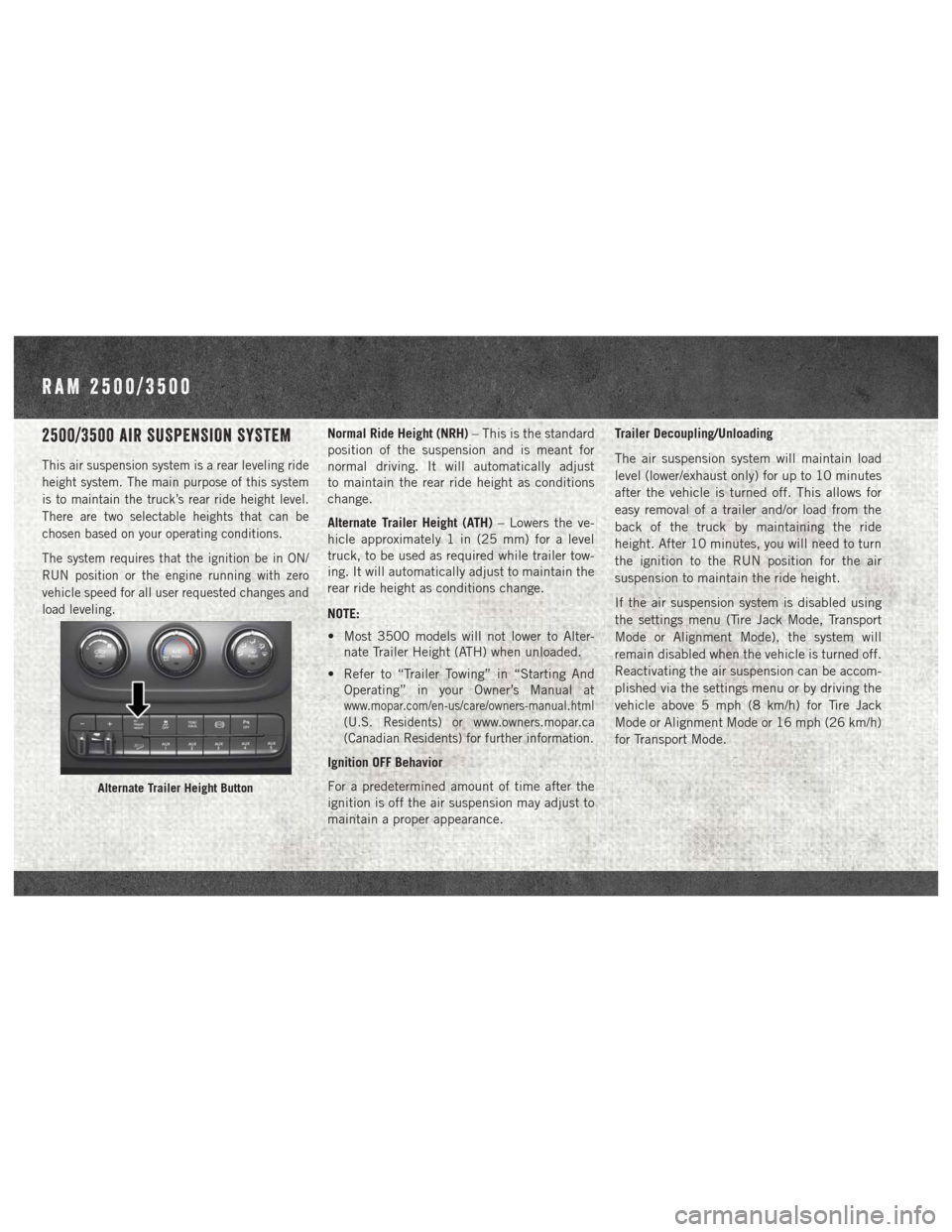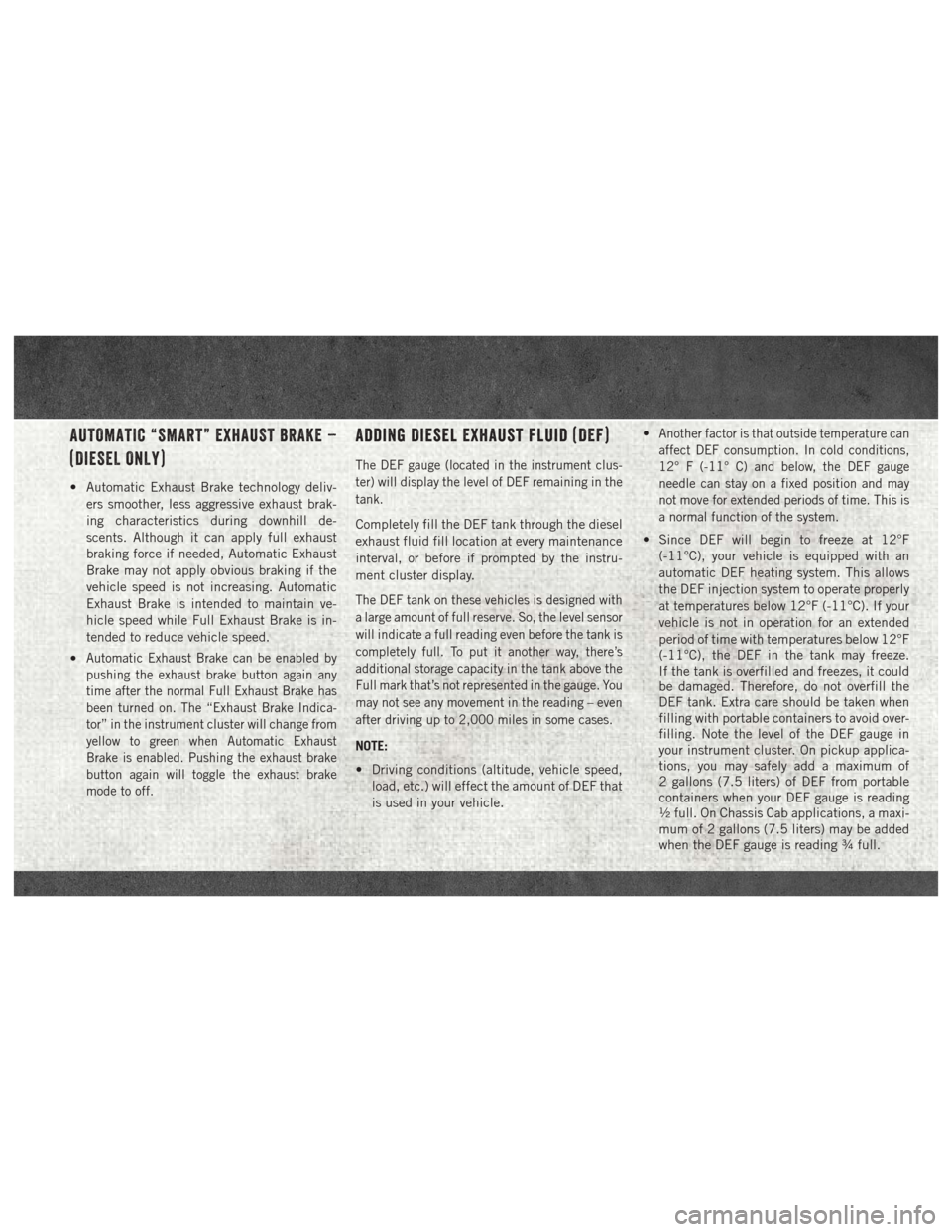change time Ram 3500 2018 Quick Reference Guide
[x] Cancel search | Manufacturer: RAM, Model Year: 2018, Model line: 3500, Model: Ram 3500 2018Pages: 20, PDF Size: 0.97 MB
Page 10 of 20

2500/3500 AIR SUSPENSION SYSTEM
This air suspension system is a rear leveling ride
height system. The main purpose of this system
is to maintain the truck’s rear ride height level.
There are two selectable heights that can be
chosen based on your operating conditions.
The system requires that the ignition be in ON/
RUN position or the engine running with zero
vehicle speed for all user requested changes and
load leveling.
Normal Ride Height (NRH)– This is the standard
position of the suspension and is meant for
normal driving. It will automatically adjust
to maintain the rear ride height as conditions
change.
Alternate Trailer Height (A TH)– Lowers the ve-
hicle approximately 1 in (25 mm) for a level
truck, to be used as required while trailer tow-
ing. It will automatically adjust to maintain the
rear ride height as conditions change.
NOTE:
• Most 3500 models will not lower to Alter- nate Trailer Height (ATH) when unloaded.
• Refer to “Trailer Towing” in “Starting And Operating” in your Owner’s Manual at
www.mopar.com/en-us/care/owners-manual.html
(U.S. Residents) or www.owners.mopar.ca
(Canadian Residents) for further information.
Ignition OFF Behavior
For a predetermined amount of time after the
ignition is off the air suspension may adjust to
maintain a proper appearance. Trailer Decoupling/Unloading
The air suspension system will maintain load
level (lower/exhaust only) for up to 10 minutes
after the vehicle is turned off. This allows for
easy removal of a trailer and/or load from the
back of the truck by maintaining the ride
height. After 10 minutes, you will need to turn
the ignition to the RUN position for the air
suspension to maintain the ride height.
If the air suspension system is disabled using
the settings menu (Tire Jack Mode, Transport
Mode or Alignment Mode), the system will
remain disabled when the vehicle is turned off.
Reactivating the air suspension can be accom-
plished via the settings menu or by driving the
vehicle above 5 mph (8 km/h) for Tire Jack
Mode or Alignment Mode or 16 mph (26 km/h)
for Transport Mode.
Alternate Trailer Height Button
RAM 2500/3500
Page 11 of 20

AUTOMATIC “SMART” EXHAUST BRAKE –
(DIESEL ONLY)
• Automatic Exhaust Brake technology deliv-ers smoother, less aggressive exhaust brak-
ing characteristics during downhill de-
scents. Although it can apply full exhaust
braking force if needed, Automatic Exhaust
Brake may not apply obvious braking if the
vehicle speed is not increasing. Automatic
Exhaust Brake is intended to maintain ve-
hicle speed while Full Exhaust Brake is in-
tended to reduce vehicle speed.
•
Automatic Exhaust Brake can be enabled by
pushing the exhaust brake button again any
time after the normal Full Exhaust Brake has
been turned on. The “Exhaust Brake Indica-
tor” in the instrument cluster will change from
yellow to green when Automatic Exhaust
Brake is enabled. Pushing the exhaust brake
button again will toggle the exhaust brake
mode to off.
Adding Diesel Exhaust Fluid (DEF)
The DEF gauge (located in the instrument clus-
ter) will display the level of DEF remaining in the
tank.
Completely fill the DEF tank through the diesel
exhaust fluid fill location at every maintenance
interval, or before if prompted by the instru-
ment cluster display.
The DEF tank on these vehicles is designed with
a large amount of full reserve. So, the level sensor
will indicate a full reading even before the tank is
completely full. To put it another way, there’s
additional storage capacity in the tank above the
Full mark that’s not represented in the gauge. You
may not see any movement in the reading – even
after driving up to 2,000 miles in some cases.
NOTE:
• Driving conditions (altitude, vehicle speed, load, etc.) will effect the amount of DEF that
is used in your vehicle. •
Another factor is that outside temperature can
affect DEF consumption. In cold conditions,
12° F (-11° C) and below, the DEF gauge
needle can stay on a fixed position and may
not move for extended periods of time. This is
a normal function of the system.
• Since DEF will begin to freeze at 12°F
(-11°C), your vehicle is equipped with an
automatic DEF heating system. This allows
the DEF injection system to operate properly
at temperatures below 12°F (-11°C). If your
vehicle is not in operation for an extended
period of time with temperatures below 12°F
(-11°C), the DEF in the tank may freeze.
If the tank is overfilled and freezes, it could
be damaged. Therefore, do not overfill the
DEF tank. Extra care should be taken when
filling with portable containers to avoid over-
filling. Note the level of the DEF gauge in
your instrument cluster. On pickup applica-
tions, you may safely add a maximum of
2 gallons (7.5 liters) of DEF from portable
containers when your DEF gauge is reading
½ full. On Chassis Cab applications, a maxi-
mum of 2 gallons (7.5 liters) may be added
when the DEF gauge is reading ¾ full.